engine coolant FORD F750 2006 11.G User Guide
[x] Cancel search | Manufacturer: FORD, Model Year: 2006, Model line: F750, Model: FORD F750 2006 11.GPages: 272, PDF Size: 1.86 MB
Page 181 of 272

ENGINE COOLING SYSTEM
If your vehicle is equipped with a Caterpillar or Cummins engine,
refer to your engine operator’s manual for engine coolant check and
adding instructions as well as fluid specifications and capacities.
Inspect cooling system daily
Note:The engine coolant reservoir requires air space for expansion
volume. The proper fill level is identified on the reservoir; do not overfill
the reservoir.
To reduce the risk of personal injury or death, use only the
following procedure to remove the pressure-type cap from the
radiator or expansion tank.
1. Always allow the engine to cool first.
2. Wrap a thick, heavy cloth around the cap.
3. Loosen the cap slowly, then pause a moment. This will reduce the risk
of possible scalding by hot water or steam.
4. Continue to unscrew the cap and remove only after pressure in the
radiator is fully released.
Note:If the coolant should get extremely low and the engine very hot,
let the engine cool for approximately 15 minutes before adding coolant.
After the engine has cooled, start the engine and add coolant slowly.
Adding coolant to a hot engine may crack the cylinder head or
crankcase. Never use only water to fill the cooling system.
Adding engine coolant - 6.0L Power Stroke
When adding coolant, make sure it is a 50/50 mixture of engine coolant
and distilled water. Add the mixture to the coolant reservoir,when the
engine is cool, until the appropriate fill level is obtained.
To reduce the risk of personal injury, make sure the engine is
cool before unscrewing the coolant pressure relief cap. The
cooling system is under pressure; steam and hot liquid can come out
forcefully when the cap is loosened slightly.
Do not add engine coolant when the engine is hot. Steam and
scalding liquids released from a hot cooling system can burn you
badly. Also, you can be burned if you spill coolant on hot engine parts.
2006 F-650/750(f67)
Supplement
USA(fus)
Maintenance and Specifications
181
Page 182 of 272
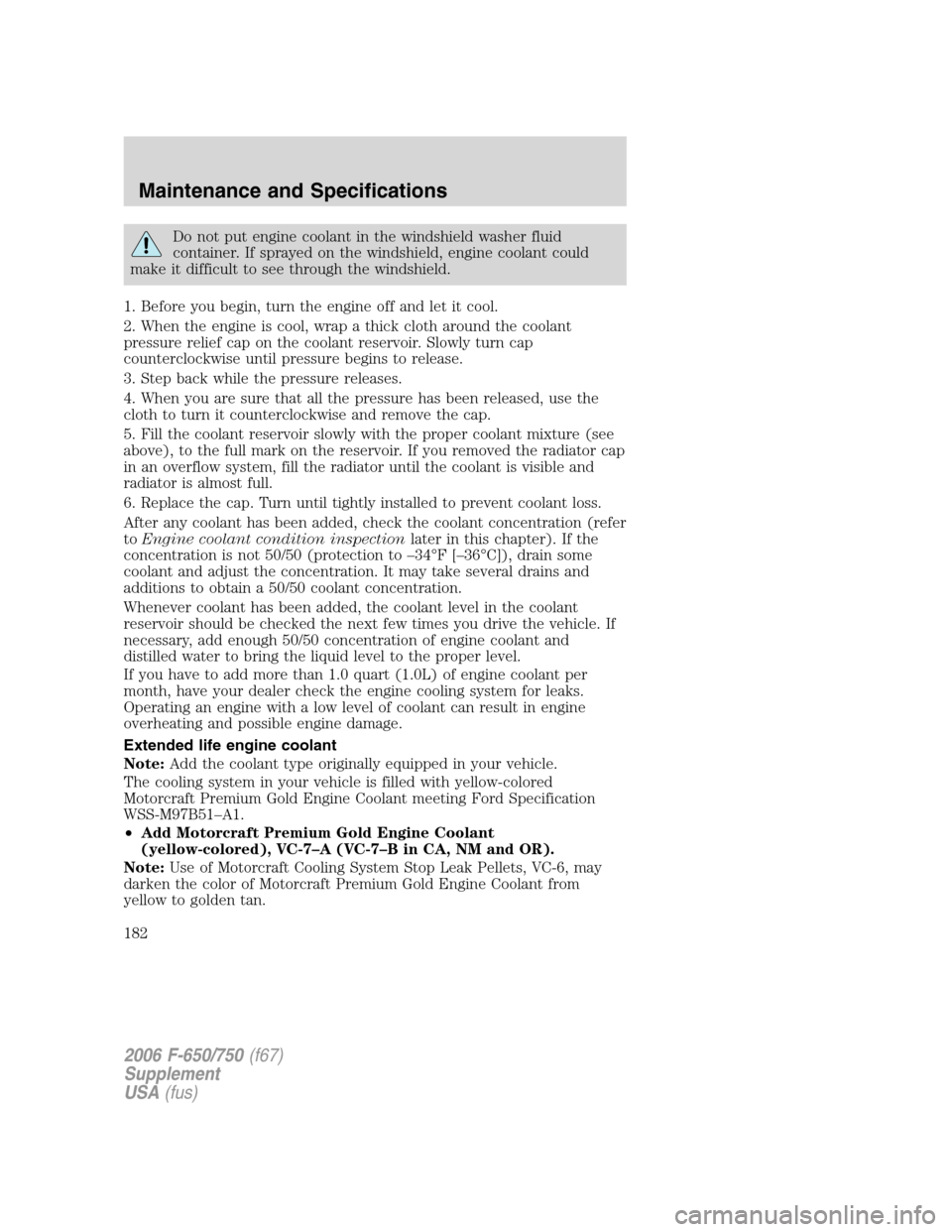
Do not put engine coolant in the windshield washer fluid
container. If sprayed on the windshield, engine coolant could
make it difficult to see through the windshield.
1. Before you begin, turn the engine off and let it cool.
2. When the engine is cool, wrap a thick cloth around the coolant
pressure relief cap on the coolant reservoir. Slowly turn cap
counterclockwise until pressure begins to release.
3. Step back while the pressure releases.
4. When you are sure that all the pressure has been released, use the
cloth to turn it counterclockwise and remove the cap.
5. Fill the coolant reservoir slowly with the proper coolant mixture (see
above), to the full mark on the reservoir. If you removed the radiator cap
in an overflow system, fill the radiator until the coolant is visible and
radiator is almost full.
6. Replace the cap. Turn until tightly installed to prevent coolant loss.
After any coolant has been added, check the coolant concentration (refer
toEngine coolant condition inspectionlater in this chapter). If the
concentration is not 50/50 (protection to –34°F [–36°C]), drain some
coolant and adjust the concentration. It may take several drains and
additions to obtain a 50/50 coolant concentration.
Whenever coolant has been added, the coolant level in the coolant
reservoir should be checked the next few times you drive the vehicle. If
necessary, add enough 50/50 concentration of engine coolant and
distilled water to bring the liquid level to the proper level.
If you have to add more than 1.0 quart (1.0L) of engine coolant per
month, have your dealer check the engine cooling system for leaks.
Operating an engine with a low level of coolant can result in engine
overheating and possible engine damage.
Extended life engine coolant
Note:Add the coolant type originally equipped in your vehicle.
The cooling system in your vehicle is filled with yellow-colored
Motorcraft Premium Gold Engine Coolant meeting Ford Specification
WSS-M97B51–A1.
•Add Motorcraft Premium Gold Engine Coolant
(yellow-colored), VC-7–A (VC-7–B in CA, NM and OR).
Note:Use of Motorcraft Cooling System Stop Leak Pellets, VC-6, may
darken the color of Motorcraft Premium Gold Engine Coolant from
yellow to golden tan.
2006 F-650/750(f67)
Supplement
USA(fus)
Maintenance and Specifications
182
Page 183 of 272
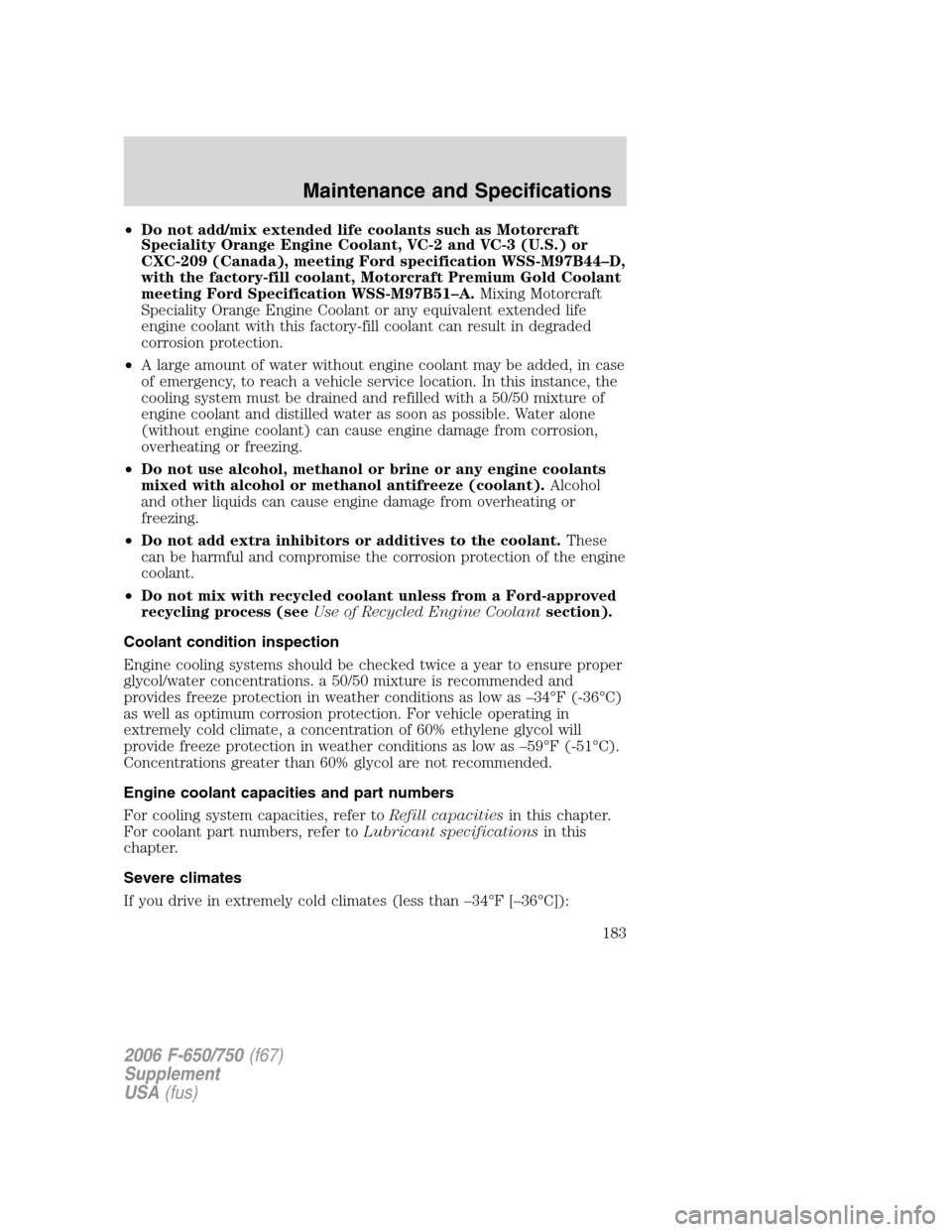
•Do not add/mix extended life coolants such as Motorcraft
Speciality Orange Engine Coolant, VC-2 and VC-3 (U.S.) or
CXC-209 (Canada), meeting Ford specification WSS-M97B44–D,
with the factory-fill coolant, Motorcraft Premium Gold Coolant
meeting Ford Specification WSS-M97B51–A.Mixing Motorcraft
Speciality Orange Engine Coolant or any equivalent extended life
engine coolant with this factory-fill coolant can result in degraded
corrosion protection.
•A large amount of water without engine coolant may be added, in case
of emergency, to reach a vehicle service location. In this instance, the
cooling system must be drained and refilled with a 50/50 mixture of
engine coolant and distilled water as soon as possible. Water alone
(without engine coolant) can cause engine damage from corrosion,
overheating or freezing.
•Do not use alcohol, methanol or brine or any engine coolants
mixed with alcohol or methanol antifreeze (coolant).Alcohol
and other liquids can cause engine damage from overheating or
freezing.
•Do not add extra inhibitors or additives to the coolant.These
can be harmful and compromise the corrosion protection of the engine
coolant.
•Do not mix with recycled coolant unless from a Ford-approved
recycling process (seeUse of Recycled Engine Coolantsection).
Coolant condition inspection
Engine cooling systems should be checked twice a year to ensure proper
glycol/water concentrations. a 50/50 mixture is recommended and
provides freeze protection in weather conditions as low as –34°F (-36°C)
as well as optimum corrosion protection. For vehicle operating in
extremely cold climate, a concentration of 60% ethylene glycol will
provide freeze protection in weather conditions as low as –59°F (-51°C).
Concentrations greater than 60% glycol are not recommended.
Engine coolant capacities and part numbers
For cooling system capacities, refer toRefill capacitiesin this chapter.
For coolant part numbers, refer toLubricant specificationsin this
chapter.
Severe climates
If you drive in extremely cold climates (less than –34°F [–36°C]):
2006 F-650/750(f67)
Supplement
USA(fus)
Maintenance and Specifications
183
Page 184 of 272

•It may be necessary to increase the coolant concentration
above 50%.
•NEVER increase the coolant concentration above 60%.
•Engine coolant concentrations above 60% will decrease the
overheat protection characteristics of the engine coolant and
may cause engine damage.
•If available, refer to the chart on the coolant container to
ensure the coolant concentration in your vehicle will provide
adequate freeze protection at the temperatures in which you
drive in the winter months.
If you drive in extremely hot climates:
•It is still necessary to maintain the coolant concentration
above 40%.
•NEVER decrease the coolant concentration below 40%.
•Engine coolant concentrations below 40% will decrease the
corrosion protection characteristics of the engine coolant and
may cause engine damage.
•Engine coolant concentrations below 40% will decrease the
freeze protection characteristics of the engine coolant and may
cause engine damage.
•If available, refer to the chart on the coolant container to
ensure the coolant concentration in your vehicle will provide
adequate protection at the temperatures in which you drive.
Vehicles driven year-round in non-extreme climates should use a 50/50
mixture of engine coolant and distilled water for optimum cooling system
and engine protection.
Fan clutches
Your vehicle’s cooling system is equipped with a viscous fan clutch.
•The fan clutch helps control cooling, increase performance, improve
fuel economy and reduce noise.
•The fan clutch is controlled by bimetallic spring sensors. Do not
tamper with these sensors as this may change their calibration or keep
the fan clutch from operating at all.
Stay clear of the fan/fan area while the engine is running or
possible personal injury may occur.
2006 F-650/750(f67)
Supplement
USA(fus)
Maintenance and Specifications
184
Page 185 of 272
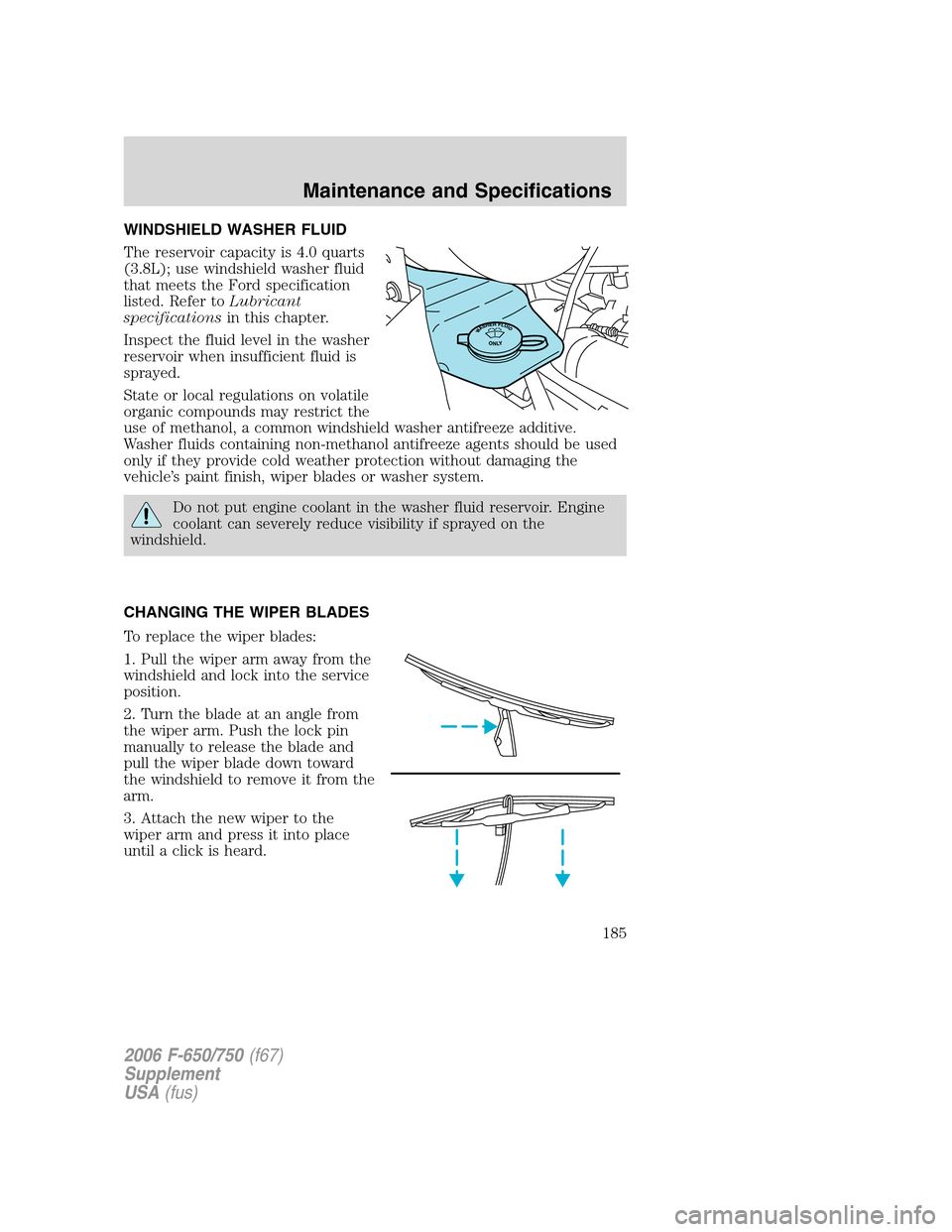
WINDSHIELD WASHER FLUID
The reservoir capacity is 4.0 quarts
(3.8L); use windshield washer fluid
that meets the Ford specification
listed. Refer toLubricant
specificationsin this chapter.
Inspect the fluid level in the washer
reservoir when insufficient fluid is
sprayed.
State or local regulations on volatile
organic compounds may restrict the
use of methanol, a common windshield washer antifreeze additive.
Washer fluids containing non-methanol antifreeze agents should be used
only if they provide cold weather protection without damaging the
vehicle’s paint finish, wiper blades or washer system.
Do not put engine coolant in the washer fluid reservoir. Engine
coolant can severely reduce visibility if sprayed on the
windshield.
CHANGING THE WIPER BLADES
To replace the wiper blades:
1. Pull the wiper arm away from the
windshield and lock into the service
position.
2. Turn the blade at an angle from
the wiper arm. Push the lock pin
manually to release the blade and
pull the wiper blade down toward
the windshield to remove it from the
arm.
3. Attach the new wiper to the
wiper arm and press it into place
until a click is heard.
2006 F-650/750(f67)
Supplement
USA(fus)
Maintenance and Specifications
185
Page 221 of 272
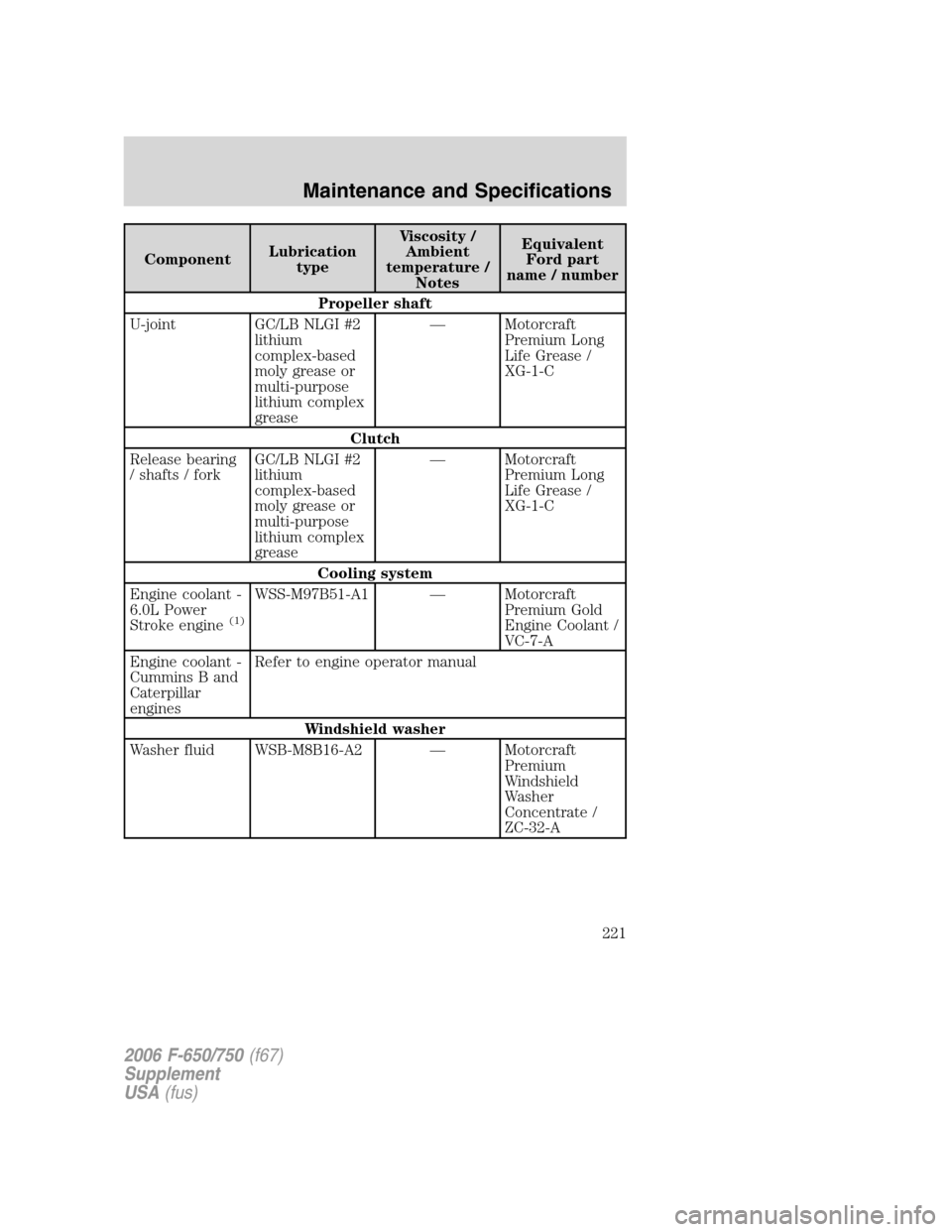
ComponentLubrication
typeViscosity /
Ambient
temperature /
NotesEquivalent
Ford part
name / number
Propeller shaft
U-joint GC/LB NLGI #2
lithium
complex-based
moly grease or
multi-purpose
lithium complex
grease— Motorcraft
Premium Long
Life Grease /
XG-1-C
Clutch
Release bearing
/ shafts / forkGC/LB NLGI #2
lithium
complex-based
moly grease or
multi-purpose
lithium complex
grease— Motorcraft
Premium Long
Life Grease /
XG-1-C
Cooling system
Engine coolant -
6.0L Power
Stroke engine
(1)
WSS-M97B51-A1 — Motorcraft
Premium Gold
Engine Coolant /
VC-7-A
Engine coolant -
Cummins B and
Caterpillar
enginesRefer to engine operator manual
Windshield washer
Washer fluid WSB-M8B16-A2 — Motorcraft
Premium
Windshield
Washer
Concentrate /
ZC-32-A
2006 F-650/750(f67)
Supplement
USA(fus)
Maintenance and Specifications
221
Page 230 of 272
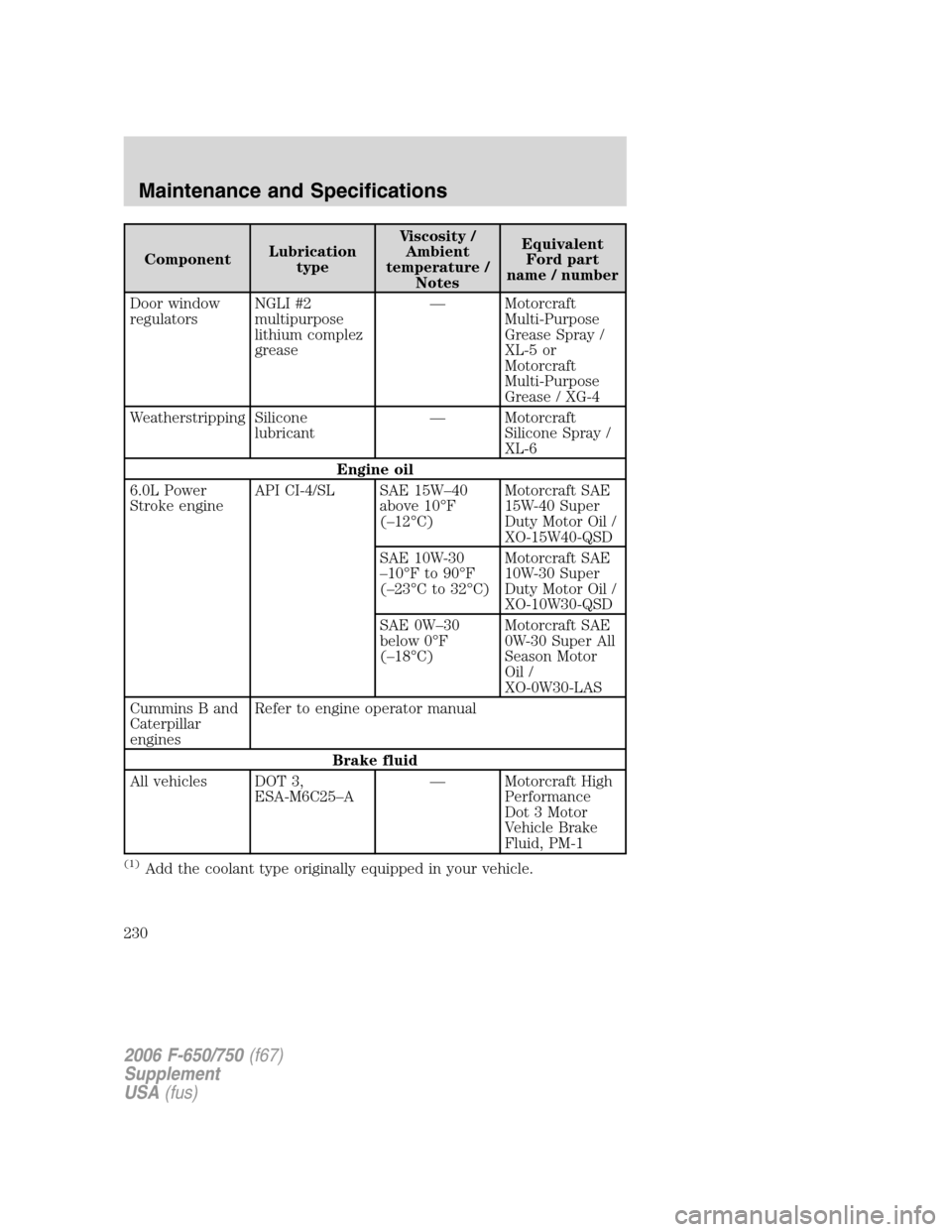
ComponentLubrication
typeViscosity /
Ambient
temperature /
NotesEquivalent
Ford part
name / number
Door window
regulatorsNGLI #2
multipurpose
lithium complez
grease— Motorcraft
Multi-Purpose
Grease Spray /
XL-5 or
Motorcraft
Multi-Purpose
Grease / XG-4
Weatherstripping Silicone
lubricant— Motorcraft
Silicone Spray /
XL-6
Engine oil
6.0L Power
Stroke engineAPI CI-4/SL SAE 15W–40
above 10°F
(–12°C)Motorcraft SAE
15W-40 Super
Duty Motor Oil /
XO-15W40-QSD
SAE 10W-30
–10°F to 90°F
(–23°C to 32°C)Motorcraft SAE
10W-30 Super
Duty Motor Oil /
XO-10W30-QSD
SAE 0W–30
below 0°F
(–18°C)Motorcraft SAE
0W-30 Super All
Season Motor
Oil /
XO-0W30-LAS
Cummins B and
Caterpillar
enginesRefer to engine operator manual
Brake fluid
All vehicles DOT 3,
ESA-M6C25–A— Motorcraft High
Performance
Dot 3 Motor
Vehicle Brake
Fluid, PM-1
(1)Add the coolant type originally equipped in your vehicle.
2006 F-650/750(f67)
Supplement
USA(fus)
Maintenance and Specifications
230
Page 232 of 272

Engine coolant and oil
Engine typeEngine coolant
(approximate
capacity)(1)
Engine oil
(approximate
capacity)
6.0L Power Stroke54.4 pints
(25.7L)19.0 quarts
(18.0L)
Caterpillar60.0 pints
(28.4L)Refer to the
engine operator
manual for
engine oil refill
capacities. Cummins B48.8 pints
(23.1L)
(1)Add the coolant originally equipped in your vehicle.
Power steering system
Steering gear Power steering fluid volume
TAS40 17.6 pints
TAS65 18.4 pints
Transmission
Description Pints (Liters)
Allison 3000/3500 5–speed automatic 58.0 (27.4)*
Allison 3000/3500 6–speed automatic 58.0 (27.4)*
2200/2500 Series 5–speed automatic 38.0 (18.0)*
FS-4205A 5–speed manual 11.5 (5.4)
FS-5205A 5–speed manual 12.5 (5.9)
FS-5406A/5406N 6–speed manual 19.5 (9.2)
FS-6406A/6406N 6–speed manual 19.5 (9.2)
ES56–7B/ES066–7B 7–speed manual 20.9 (9.9)
FR-9210B 10–speed manual 23.5 (11.1)
RT–8908LL 10–speed manual 28.0 (13.2)
*Total fluid capacity (dry transmission and torque converter).
2006 F-650/750(f67)
Supplement
USA(fus)
Maintenance and Specifications
232
Page 241 of 272
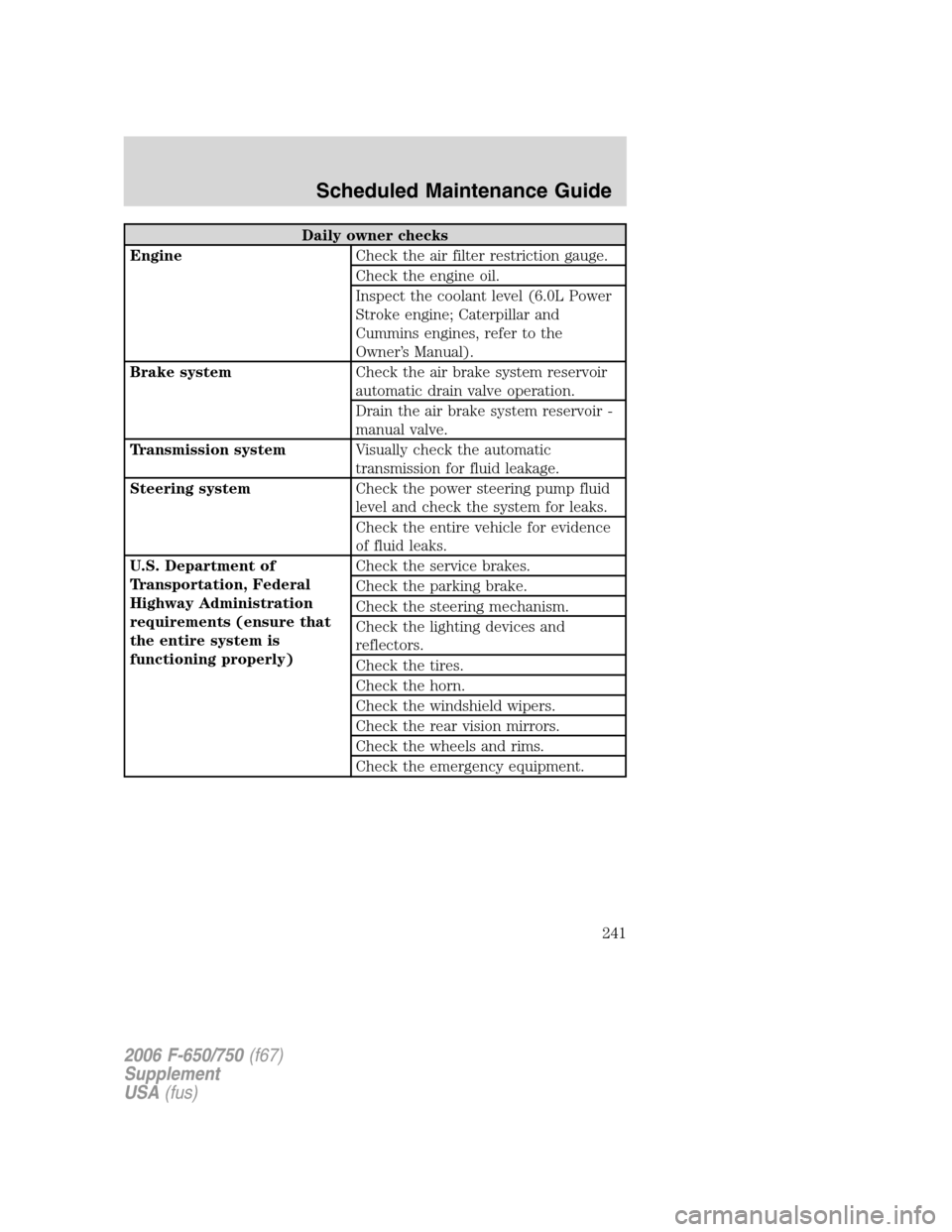
Daily owner checks
EngineCheck the air filter restriction gauge.
Check the engine oil.
Inspect the coolant level (6.0L Power
Stroke engine; Caterpillar and
Cummins engines, refer to the
Owner’s Manual).
Brake systemCheck the air brake system reservoir
automatic drain valve operation.
Drain the air brake system reservoir -
manual valve.
Transmission systemVisually check the automatic
transmission for fluid leakage.
Steering systemCheck the power steering pump fluid
level and check the system for leaks.
Check the entire vehicle for evidence
of fluid leaks.
U.S. Department of
Transportation, Federal
Highway Administration
requirements (ensure that
the entire system is
functioning properly)Check the service brakes.
Check the parking brake.
Check the steering mechanism.
Check the lighting devices and
reflectors.
Check the tires.
Check the horn.
Check the windshield wipers.
Check the rear vision mirrors.
Check the wheels and rims.
Check the emergency equipment.
2006 F-650/750(f67)
Supplement
USA(fus)
Scheduled Maintenance Guide
241
Page 243 of 272
![FORD F750 2006 11.G User Guide Check every oil change (Oil change interval for the 6.0L Power
Stroke engine is 10,000 miles [16,000 km]; (refer to the
Caterpillar and Cummins service manuals for instructions and
information)
Fuel s FORD F750 2006 11.G User Guide Check every oil change (Oil change interval for the 6.0L Power
Stroke engine is 10,000 miles [16,000 km]; (refer to the
Caterpillar and Cummins service manuals for instructions and
information)
Fuel s](/img/11/5072/w960_5072-242.png)
Check every oil change (Oil change interval for the 6.0L Power
Stroke engine is 10,000 miles [16,000 km]; (refer to the
Caterpillar and Cummins service manuals for instructions and
information)
Fuel systemDrain the accumulated water or
sediment from the fuel tank(s).
Steering systemLubricate the steering shaft(s),
U-joints and splines when equipped
with grease fittings.
Lubricate the front axle spindle pins.
Lubricate the steering linkage when
equipped with grease fittings.
Grease the power steering gear output
shaft.
* Coolant protection checks should be made just prior to the onset of
freezing weather, where applicable. If coolant is dirty or rusty in
appearance, the system should be drained, flushed and refilled with the
prescribed solution of cooling system fluid and water. Use only
permanent type coolant that meets Ford specifications
WSS-M97B51-A1. See the engine manufacturer’s operating guide for
supplemental corrosion inhibitor specifications.
In addition to the items to be performed daily or at each oil change, the
following need to be completed as specified:
GENERAL MAINTENANCE SERVICES
The following are vehicle checks that should be made periodically either
by the owner or a qualified technician. It is recommended that
deficiencies be brought to the attention of your dealer or another
qualified service outlet as soon as possible in order that advice regarding
the need for service or replacement can be obtained.
2006 F-650/750(f67)
Supplement
USA(fus)
Scheduled Maintenance Guide
243